初中英语的不定式和动名词(整理版)教学内容
- 格式:doc
- 大小:48.00 KB
- 文档页数:6
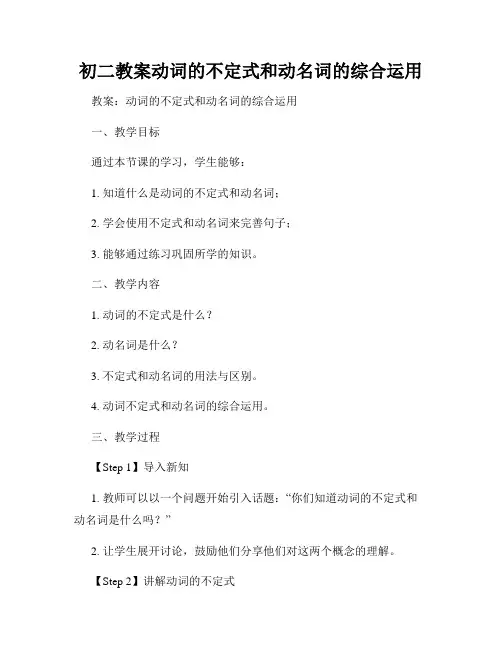
初二教案动词的不定式和动名词的综合运用教案:动词的不定式和动名词的综合运用一、教学目标通过本节课的学习,学生能够:1. 知道什么是动词的不定式和动名词;2. 学会使用不定式和动名词来完善句子;3. 能够通过练习巩固所学的知识。
二、教学内容1. 动词的不定式是什么?2. 动名词是什么?3. 不定式和动名词的用法与区别。
4. 动词不定式和动名词的综合运用。
三、教学过程【Step 1】导入新知1. 教师可以以一个问题开始引入话题:“你们知道动词的不定式和动名词是什么吗?”2. 让学生展开讨论,鼓励他们分享他们对这两个概念的理解。
【Step 2】讲解动词的不定式1. 教师通过示例句子来解释动词的不定式。
例句1:I want to go to the park.(我想去公园。
)例句2:She needs to study for the exam.(她需要为考试学习。
)2. 引导学生总结不定式的形式和用法。
形式:to + 动词原形用法:作为动词的宾语、目的、目的地、原因等。
【Step 3】讲解动名词1. 教师通过示例句子来解释动名词。
例句1:I enjoy swimming in the pool.(我喜欢在游泳池里游泳。
)例句2:He is good at playing basketball.(他擅长打篮球。
)2. 引导学生总结动名词的形式和用法。
形式:动词原形 + -ing用法:作为主语、宾语、介词宾语等。
【Step 4】区分不定式和动名词的用法1. 教师列出几个具体的例子,让学生通过分析句子结构判断其中是用不定式还是动名词。
例子:I want to play soccer.(我想踢足球。
)He enjoys playing the piano.(他喜欢弹钢琴。
)2. 通过对比,帮助学生理解不定式和动名词在句子中的不同用法。
【Step 5】综合运用1. 教师提供一些练习题,让学生使用不定式或动名词来完善句子。
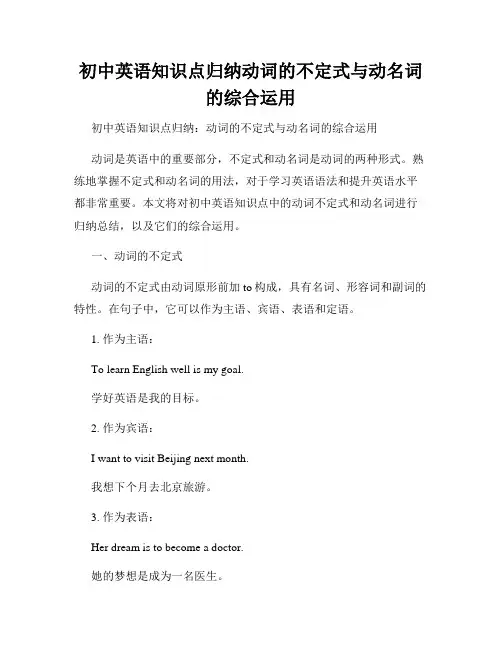
初中英语知识点归纳动词的不定式与动名词的综合运用初中英语知识点归纳:动词的不定式与动名词的综合运用动词是英语中的重要部分,不定式和动名词是动词的两种形式。
熟练地掌握不定式和动名词的用法,对于学习英语语法和提升英语水平都非常重要。
本文将对初中英语知识点中的动词不定式和动名词进行归纳总结,以及它们的综合运用。
一、动词的不定式动词的不定式由动词原形前加to构成,具有名词、形容词和副词的特性。
在句子中,它可以作为主语、宾语、表语和定语。
1. 作为主语:To learn English well is my goal.学好英语是我的目标。
2. 作为宾语:I want to visit Beijing next month.我想下个月去北京旅游。
3. 作为表语:Her dream is to become a doctor.她的梦想是成为一名医生。
4. 作为定语:I have a book to read.我有一本书可以读。
二、动名词动名词是动词加-ing形式,具有名词的特性。
它可以作为主语、宾语、表语和定语。
1. 作为主语:Reading is my favorite hobby.阅读是我的最爱。
2. 作为宾语:She enjoys singing and dancing.她喜欢唱歌和跳舞。
3. 作为表语:Her job is teaching English.她的工作是教英语。
4. 作为定语:The running water sounds so refreshing.流水的声音听起来很清新。
三、不定式与动名词的综合运用在实际应用中,我们经常需要将不定式和动名词结合使用,构成复合结构,完成句子的表达。
1. 不定式与动名词作为复合宾语:She enjoys playing the piano.她喜欢弹钢琴。
2. 不定式与动名词作为复合宾语:I want to go swimming this weekend.我想这周末去游泳。

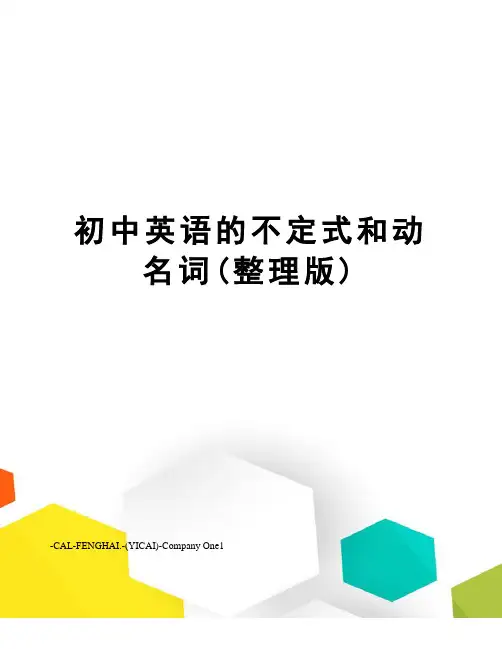
初中英语的不定式和动名词(整理版)-CAL-FENGHAI.-(YICAI)-Company One1初中不定式和动名词一、动词不定式:构成:to + 动词原形1. 下列动词只能接不定式作:want 想要, agree 同意, choose 选择, decide 决定, expect 期望,hope 希望, earn 学会, need 必要, offer 提供, prefer 宁愿, +to dopromise保证, plan 计划 refuse 拒绝, wish 希望, would like想要2. 下列动词只能接动名词(即动词+ing)Enjoy; mind; practice; finish;suggest ;deny;admit ; keep; spend; feel like + doing sth.enjoy doing sth., 喜欢做某事 mind doing sth. 介意做某事,practice doing sth. 练习做某事 finish doing sth. 做完某事feel like doing sth. 想要做某事 keep doing sth. 坚持做某事have fun doing sth. 尽情做某事 suggest doing sth.建议做某事deny doing sth. 否认做某事 admit doing sth.承认做某事be/get used to doing sth. 习惯做某事 look forward to doing sth. 盼望做某事spend…(in) doing sth. 花费时间做某事 can’t help doing sth. 情不自禁做某事be busy doing sth 忙于做某事 be worth doing sth 值得做某事prefer doing sth. to doing sth 与…相比更喜欢做某事pay attention to doing sth. 注意做某事3.有些动词后面既可接不定式,也可接动名词,意思相同。

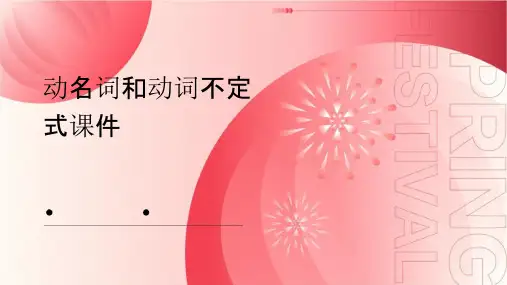
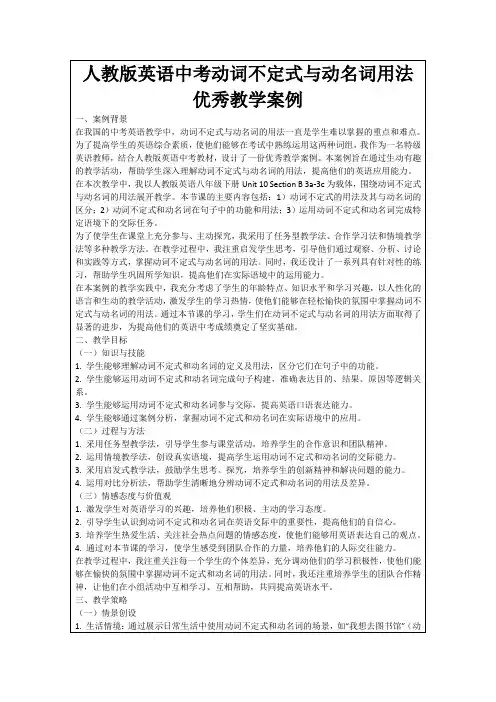
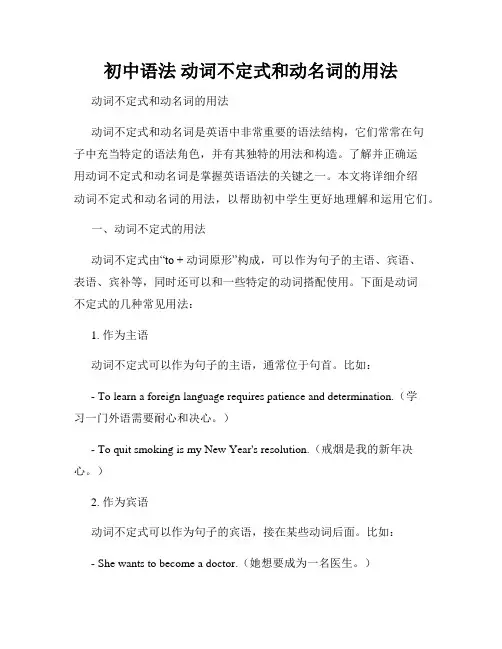
初中语法动词不定式和动名词的用法动词不定式和动名词的用法动词不定式和动名词是英语中非常重要的语法结构,它们常常在句子中充当特定的语法角色,并有其独特的用法和构造。
了解并正确运用动词不定式和动名词是掌握英语语法的关键之一。
本文将详细介绍动词不定式和动名词的用法,以帮助初中学生更好地理解和运用它们。
一、动词不定式的用法动词不定式由“to + 动词原形”构成,可以作为句子的主语、宾语、表语、宾补等,同时还可以和一些特定的动词搭配使用。
下面是动词不定式的几种常见用法:1. 作为主语动词不定式可以作为句子的主语,通常位于句首。
比如:- To learn a foreign language requires patience and determination.(学习一门外语需要耐心和决心。
)- To quit smoking is my New Year's resolution.(戒烟是我的新年决心。
)2. 作为宾语动词不定式可以作为句子的宾语,接在某些动词后面。
比如:- She wants to become a doctor.(她想要成为一名医生。
)- He enjoys playing basketball.(他喜欢打篮球。
)3. 作为表语动词不定式可以作为句子的表语,通常与be动词连用。
比如:- His dream is to travel around the world.(他的梦想是周游世界。
)- The most important thing is to believe in yourself.(最重要的事情是相信自己。
)4. 作为宾补某些动词后面可以接动词不定式作为宾补,表示动作的目的、结果或意图。
比如:- He wants to buy a new car.(他想要买一辆新车。
)- I need to finish my homework before dinner.(我需要在晚餐前完成我的作业。

初中英语知识点归纳动词的不定式和动名词用法总结动词的不定式和动名词是英语学习中的重要知识点,它们的用法十分多样且常见。
本文将对动词的不定式和动名词的用法进行总结和归纳。
一、动词不定式1. 作主语:例句:To succeed in life is his ultimate goal.成功是他追求的终极目标。
2. 作宾语:a. 接及物动词的宾语:例句:I want to learn English.我想学英语。
b. 接不及物动词的宾语:例句:She decided to go hiking.她决定去徒步旅行。
3. 作表语:例句:Her dream is to become a doctor.她的梦想是成为一名医生。
4. 作补语:a. 表示命令、建议、请求等:例句:She told me to wait for her at the gate.她告诉我在门口等她。
b. 表示目的、目标等:例句:He went to the store to buy some groceries.他去商店买一些杂货。
5. 作定语:例句:We need a person to help us with the project.我们需要一个人来帮助我们完成这个项目。
6. 作状语:a. 表示目的、结果、原因等:例句:He studied hard to pass the exam.他努力学习为了通过考试。
b. 表示时间、条件等:例句:I woke up early to catch the bus.我早起为了赶公交车。
二、动名词1. 作主语:例句:Swimming is my favorite sport.游泳是我最喜欢的运动。
2. 作宾语:例句:I enjoy reading books in my free time.我喜欢在空闲时间读书。
3. 作表语:例句:Her hobby is dancing.她的爱好是跳舞。
4. 作补语:例句:His job is teaching English.他的工作是教英语。

动名词与不定式的区别及应用教案一、教学目标:1.知道动名词和不定式的基本用法和区别2.能够在语言学习和交流中正确使用动名词和不定式二、教学内容:1.动名词和不定式的定义2.动名词和不定式的基本用法3.动名词和不定式的区别及其在句子中的应用三、教学重难点:1.动名词的用法和其与不定式的区别2.如何在句子中运用动名词和不定式四、教学方法:1.讲授法2.组合法3.演示法五、教学过程:步骤一:说课动名词和不定式是英语语法中非常重要的一个部分,因为它们经常出现在文章、对话和写作中。
因此,对于学习英语的学生来说,学习动名词和不定式的用法是非常必要的。
本次教学将着重介绍动名词和不定式的用法和区别,并结合实际例子进行讲解。
步骤二:引入让学生听一段对话,然后提问:-A: What do you like doing in your free time?-B: I like to read books and go hiking.-A: Oh, I like reading too. But I prefer watching movies.引入这段对话是为了让学生看到动名词和不定式的应用,并引出下一个问题:在这个句子中,“reading”和“to read”有什么区别?步骤三:详细讲解动名词的用法:动名词是动词+“-ing”,它可以表示以下意思:1.表示某种活动或正在做某事-I enjoy swimming in the sea.-He hates shopping with his wife.2.表示某物的特定用途或功能-The scissors are for cutting paper.-The rope is for tying things up.3.作为名词的补语-His favorite hobby is playing soccer.-My dream is traveling around the world.4.作为介词后的宾语-She’s thinking about studying abroad next year.-Have you ever thought about going to Japan?不定式的用法:不定式是由“to”加上动词原形组成,它可以表示以下意思:1.表示将要做某事或计划去做某事-I’m going to visit my grandparents tomorrow.-She wants to be a doctor when she grows up.2.表示能力或意愿-He can't swim yet, but he wants to learn.-She would like to go to the cinema tonight.3.作为形容词或介词后的宾语-I have a lot of things to do tomorrow.-It's difficult to speak a foreign language fluently.动名词和不定式的区别:1.动名词可以作主语、宾语和表语,不定式只能作宾语。

初中英语语法精讲动词不定式用法(教案)章节一:动词不定式的概念与构成教学目标:1. 让学生理解动词不定式的概念。
2. 让学生掌握动词不定式的构成。
3. 让学生能够正确运用动词不定式作主语、宾语和表语。
教学内容:1. 动词不定式的概念:动词不定式是一种没有主语和宾语的句子形式,由动词原形加上“to”构成。
2. 动词不定式的构成:动词原形+ “to”。
3. 动词不定式的基本用法:a. 作主语:如:To see is to believe.b. 作宾语:如:I want to go.c. 作表语:如:His goal is to study hard.教学活动:1. 引入动词不定式的概念,让学生通过实例理解。
2. 讲解动词不定式的构成,让学生进行练习。
3. 分组讨论,让学生用动词不定式作主语、宾语和表语造句。
章节二:动词不定式的否定形式教学目标:1. 让学生掌握动词不定式的否定形式。
2. 让学生能够正确运用动词不定式的否定形式。
1. 动词不定式的否定形式:在“to”前面加上“not”,即“not to”。
2. 动词不定式的否定形式的用法:表示否定意义,如:I don't want to go.教学活动:1. 讲解动词不定式的否定形式,让学生进行练习。
2. 小组活动,让学生用动词不定式的否定形式造句。
章节三:动词不定式的疑问形式教学目标:1. 让学生掌握动词不定式的疑问形式。
2. 让学生能够正确运用动词不定式的疑问形式。
教学内容:1. 动词不定式的疑问形式:在“to”前面加上“do/does/did”,如:Do you want to go?2. 动词不定式的疑问形式的用法:用于提问,如:Do you want to go shopping?教学活动:1. 讲解动词不定式的疑问形式,让学生进行练习。
2. 小组活动,让学生用动词不定式的疑问形式提问。
章节四:动词不定式作主语教学目标:1. 让学生掌握动词不定式作主语的用法。
初中英语知识点归纳动名词和不定式的用法初中英语知识点归纳:动名词和不定式的用法动名词(Gerund)和不定式(Infinitive)是初中英语中常用的语法形式,它们在句子中有着不同的用法和作用。
下面对动名词和不定式的用法进行归纳总结。
一、动名词的用法:1. 作主语:动名词可以作为整个句子的主语。
- Running is good exercise. (跑步是一项很好的运动。
)- Singing makes me happy. (唱歌使我开心。
)2. 作宾语:动名词可以作动词的宾语。
- I enjoy playing basketball. (我喜欢打篮球。
)- He hates doing homework. (他讨厌做作业。
)3. 作介词的宾语:动名词可以作介词的宾语。
- She is good at dancing. (她擅长跳舞。
)- They are interested in painting. (他们对绘画感兴趣。
)4. 在某些固定短语中:动名词常用于一些固定搭配中。
- I look forward to seeing you. (我期待见到你。
)- He is busy with studying. (他忙于学习。
)5. 作宾补:动名词可以作及物动词的宾补。
- She found it interesting watching movies. (她认为看电影很有趣。
) - They made her captain of the team. (他们让她成为队长。
)二、不定式的用法:1. 作动词的宾语:不定式可以作动词的宾语。
- I want to study abroad. (我想出国留学。
)- He loves to play the piano. (他喜欢弹钢琴。
)2. 作形容词的定语:不定式可以作名词或代词的定语。
- This is a good book to read. (这是本值得阅读的好书。
初中英语知识点归纳动词的不定式与动名词的用法动词的不定式与动名词是英语中常见的两种动词形式,它们在句子中有各自独特的用法。
本文将对初中英语中动词的不定式与动名词的用法进行归纳总结。
一、动词的不定式的用法1. 不定式作为主语不定式可以作为句子的主语,常用的句型有:- To study English is important.- To succeed needs hard work.- To learn a foreign language is challenging.2. 不定式作为宾语不定式可以作为及物动词的宾语,常用的动词有:- want, hope, plan, decide等。
例如:- She wants to go shopping.- They hope to win the game.- I plan to visit my grandparents next week.3. 不定式作为表语不定式也可以作为句子的表语,常用的句型有:- The best way to learn is to practice.- His dream is to become a doctor.- My goal is to travel around the world.4. 不定式作为状语不定式可以作为状语修饰动词、形容词或副词。
常用的句型有:- I woke up early to catch the train.- She was too tired to continue working.- He spoke slowly to make sure everyone understood.二、动名词的用法1. 动名词作为主语动名词可以作为句子的主语,常用的句型有:- Swimming is my favorite sport.- Reading books is a good way to relax.- Playing basketball requires teamwork.2. 动名词作为宾语动名词可以作为及物动词的宾语,常用的动词有:- enjoy, like, love, hate等。
初中英语的不定式和动名词(整理版)2)XXX.记得去做某事(还未做)3) XXX停止做某事(正在做)4) to do sth.停下来去做某事(为了去做)5)try XXX.试着做某事(尝试)6)try to do sth.努力去做某事(尽力)动词不定式是英语中的一种非常重要的语法结构,它可以作主语、宾语、表语、定语、状语等。
掌握好动词不定式的用法,可以使我们的英语表达更加地准确、地道。
在使用动词不定式时,需要注意动词后面要接不定式,还是动名词,以及不同的动词接不同的结构。
首先,我们需要知道哪些动词只能接不定式作宾语。
这些动词包括want、agree、choose、decide、expect、hope、earn、need、offer、prefer、promise、plan、refuse和would like等。
我们需要记住这些动词,以便在使用时不出错。
其次,还有一些动词只能接动名词作宾语,如enjoy、mind、practice、finish、suggest、deny、admit、keep、spend 和feel like等。
这些动词的用法也需要我们掌握。
除此之外,还有一些动词既可以接不定式,也可以接动名词,但意思有所不同。
例如,begin/start to do sth.和begin/start doing sth.的意思都是“开始做某事”,但前者表示动作的开始,后者则表示动作的进行。
同样地,like/love to do sth.和like/love doing sth.的意思也不同,前者表示偏好,后者则表示喜欢的状态。
最后,我们需要注意一些动词后接不定式或动名词时的区别。
例如,XXX和XXX的意思不同,前者表示记得已经做过的事情,后者则表示记得要去做某事。
类似地。
doing。
to do sth.的意思也不同,前者表示停止正在进行的动作,后者则表示停下来去做某事。
1.Remember to do something means to keep in mind that you need to do something that you haven't done yet.2.et doing something means that you have done something。
初中不定式教案教学目标:1. 让学生理解不定式的概念和用法。
2. 培养学生正确运用不定式表达目的、结果、原因等句子结构。
3. 提高学生的英语口语表达能力和写作能力。
教学重点:1. 不定式的概念和用法。
2. 不定式在句子中的功能和结构。
教学难点:1. 不定式的否定形式。
2. 不定式在句子中的正确运用。
教学准备:1. 教材:人教版初中英语教材。
2. 教学多媒体设备。
教学过程:Step 1: 导入(5分钟)1. 向学生介绍本节课的主题:不定式。
2. 引导学生回顾已学的相关知识,如动词、分词等。
Step 2: 讲解不定式(15分钟)1. 向学生讲解不定式的概念,如不定式的构成、不定式的否定形式等。
2. 通过示例讲解不定式在句子中的功能和结构,如目的状语、结果状语、原因状语等。
Step 3: 练习(15分钟)1. 让学生分组进行练习,用不定式完成目的、结果、原因等句子结构。
2. 选取部分学生的练习进行展示和点评。
Step 4: 应用(15分钟)1. 让学生运用所学的不定式知识进行口语表达,如模拟情景对话。
2. 让学生运用所学的不定式知识进行写作,如写一篇小短文。
Step 5: 总结(5分钟)1. 对本节课所学内容进行总结,强调不定式的概念和用法。
2. 提醒学生注意不定式在句子中的正确运用。
Step 6: 作业布置(5分钟)1. 让学生复习本节课所学内容,巩固不定式的概念和用法。
2. 布置一道有关不定式的课后练习题,让学生独立完成。
教学反思:通过本节课的教学,发现学生在掌握不定式的概念和用法方面存在一定的困难,特别是在不定式的否定形式和正确运用方面。
在今后的教学中,需要加强对这部分内容的讲解和练习,让学生能够更好地理解和运用不定式。
同时,也要注重培养学生的口语表达能力和写作能力,提高他们的英语综合素质。
初二教案动词的不定式和动名词初二教案: 动词的不定式和动名词一、教学目标本教案旨在教授初二学生关于动词不定式和动名词的用法、形式和区别。
通过本课的学习,学生将能够:1. 理解和区分动词不定式和动名词的功能和形式;2. 掌握动词不定式的结构和用法,包括作为主语、宾语、表语和定语;3. 掌握动名词的结构和用法,包括作为主语、宾语、表语和定语;4. 能够在句子中正确运用动词不定式和动名词。
二、教学内容1. 动词不定式的定义和形式2. 动词不定式作主语3. 动词不定式作宾语4. 动词不定式作表语5. 动词不定式作定语6. 动名词的定义和形式7. 动名词作主语8. 动名词作宾语9. 动名词作表语10. 动名词作定语三、教学过程本课分为以下几个阶段:引入:通过展示一张包含多个动词不定式和动名词的图片,引发学生对于这两个语法现象的初步认知。
初步解释:教师简要介绍动词不定式和动名词的定义和形式,并给出一些例句以加深学生的理解。
详细讲解:1. 动词不定式的用法:- 作主语:动词不定式作主语可以表示一种普遍真理或个人观点。
例如:To love is to live.- 作宾语:动词不定式作宾语可以表示动作、目的、意愿等。
例如:She wants to visit her grandmother.- 作表语:动词不定式作表语可以说明主语的特征、身份或目标。
例如:Her dream is to become a teacher.- 作定语:动词不定式作定语可以修饰名词或代词。
例如:I have a book to read tonight.2. 动名词的用法:- 作主语:动名词作主语可以表示一般真理或抽象概念。
例如:Writing is my favorite hobby.- 作宾语:动名词作宾语可以表示动作、意愿或喜好。
例如:He enjoys singing and dancing.- 作表语:动名词作表语可以说明主语的特征或身份。
初中英语动词不定式教案一、教学目标1. 了解动词不定式的构成和用法。
2. 学会正确运用动词不定式表达自己的意思。
3. 能够分辨动词不定式的主动形式和被动形式。
二、教学重点1. 学习动词不定式的构成和用法。
2. 培养学生正确使用动词不定式的能力。
3. 提供反复练习机会,确保学生掌握所学内容。
三、教学内容教学步骤一:动词不定式的构成1. 动词不定式由“to + 动词原形”构成。
2. 动词不定式作为动词的不定式短语,可以充当主语、宾语、表语、宾补和状语等。
3. 动词不定式可以用于一般现在时、一般将来时、情态动词和感官动词的宾语从句等语法结构中。
教学步骤二:动词不定式的用法1. 动词不定式作为主语:a) It is important to learn English well.b) To be happy is what we all want.2. 动词不定式作为宾语:a) I want to go to the park.b) She likes to play basketball.3. 动词不定式作为表语:a) His dream is to become a doctor.b) The most important thing is to be confident.4. 动词不定式作为宾补:a) I saw him go into the building.b) He heard her sing a beautiful song.5. 动词不定式作为状语:a) She practiced every day to improve her skills.b) He came early to catch the first bus.教学步骤三:动词不定式的被动形式1. 动词不定式的被动形式为“to be + 动词的过去分词”。
2. 动词不定式的被动形式可用于被动语态、情态动词的被动语态和被感官动词的宾语从句中。
初中不定式和动名词一、动词不定式:构成:to + 动词原形1. 下列动词只能接不定式作:want 想要, agree 同意, choose 选择, decide 决定, expect 期望,hope 希望, earn 学会, need 必要, offer 提供, prefer 宁愿, +to dopromise保证, plan 计划refuse 拒绝, wish 希望, would like想要2. 下列动词只能接动名词(即动词+ing)Enjoy; mind; practice; finish;suggest ;deny;admit ; keep; spend; feel like + doing sth.enjoy doing sth., 喜欢做某事mind doing sth. 介意做某事,practice doing sth. 练习做某事finish doing sth. 做完某事feel like doing sth. 想要做某事keep doing sth. 坚持做某事have fun doing sth. 尽情做某事suggest doing sth.建议做某事deny doing sth. 否认做某事admit doing sth.承认做某事be/get used to doing sth. 习惯做某事look forward to doing sth. 盼望做某事spend…(in) doing sth. 花费时间做某事can’t help doing sth. 情不自禁做某事be busy doing sth 忙于做某事be worth doing sth 值得做某事prefer doing sth. to doing sth 与…相比更喜欢做某事pay attention to doing sth. 注意做某事3.有些动词后面既可接不定式,也可接动名词,意思相同。
如:begin/start to do sth.= begin/start doing sth开始做某事,like/love to do sth= like / love doing sth. 喜欢做某事;hate to do sth. =hate doing sth.憎恨做某事4. 有些动词后接不定式或名词时,意思不同。
如:1)remember doing sth. 记得作过某事(某事已做过)remember to so sth.记住去做某事(某事还没做)2)forget doing sth. 忘了作过某事(某事已做过)forget to do sth. 忘了去做某事(某事还没做)3)try to do sth.=do one’s best to do sth. 尽力去做某事try doing sth. 尝试做某事4)stop doing sth. 停止做某事(停止正在做的事)stop to do sth.停下来做某事(停止的事去做另外的事)5)go on doing sth. 继续做某事(同一件事)go on to do sth. 接着去做某事(不同的事)5.下列动词跟动词不定式充当宾语补足语:vt.+sb. to do sth. vt.+ sb.+not to do sth.Want/ask/ tell /order/ allow/ wish/beg/advise / call /invite +sb. to do sth.She told me to buy a ticket.她让我去买张票My mother often tells me not to go out at night.6.help 后的不定式可带to, 也可不带toThe teachers helped the students (to) learn English well. 那些老师帮助学生学好英语。
He often helps his mother (to) tidy up the room.他经常帮助他妈妈整理房间。
7. 动词不定式省to的情况一感feel二听hear, listen to +sb. do sth.三使have, let, make四看see, watch, look at, notice常考短语:hear/see/ make / let sb. do sth.被动语态:Sb. be heard/ seen/made/let to do sth.(变成被动语态时补回to)I often see him help others. He is often seen to help other by me.二、动词不定式的句式:1..动词不定式作主语,主语较长时,常用it作形式主语,而将真正的主语放在句。
It + is/was+adj.+(for sb.) + to do sth.To learn English well is useful. = It’s useful to learn English well.学好英语是有用的。
To protect environment is important for us.= It’s important for us to protect environment.对于我们来说保护环境是很重要的。
2. It is / was + adj.(kind / good/ nice/ clever) + of sb. +to do sth.It’s very kind of you to help me. =You are very kind to help me你帮助我真是太好啦。
It’s very clever of you to do like that.=You are clever to do like that你那样做真的太聪明啦。
这个句型的形容词为表示人的品格,气质之类的词。
可以等于句型:sb. is / was + adj. +to do sth.3. It takes ( took , will take ) sb. some time to do something. (做某事花费某人…时间)4.. 主语+ find / think + it +形容词+ (for sb.) + to doI find it easy to read English every day. 我发现每天读英语和容易的。
He felt it hard to sleep.他觉得很难入睡。
I think it very interesting to learn English. 我认为学英语很有趣。
We found it impossible to cross the river. 我们发现过河是不可能的。
5.不定式作表语表示主语的“职业、职责或性质”等Her job is to clean the hall. 她的工作就是打扫大厅。
My dream is to be a teacher.我的梦想是当一名教师。
6.不定式作状语的用法He worked day and night to get the money.(表目的)他日夜工作来赚钱。
He is too young to go to school. (表结果)他太小以致不能上学。
They were very sad to hear the news.(表原因)听到这个消息他们非常伤心。
The question is simple for him to answer.(表程度)这个问题对他来说太容易回答了。
7. 动词不定式可以和疑问词who, what, which, when, how, where(why除外)等连用,构成不定式短语。
Can you tell me how to get to the post office?I didn’t know what to do next.How to learn English well is the question that we all want to ask.The question is when to get there.What to do 与how to do 的区别:I don’t know what to do next?我不知道下一步该做什么。
(What to do后没有sth.)I don’t know how to use this machine.我不知道怎么样使用这部机器(how to do +sth.)三、动名词(动词+ing)作用相当于名词。
(可以作主语、宾语、表语和定语)1.Reading is an art. 读书是一种艺术。
(作主语)2.Your task is cleaning the windows.你的任务就是擦窗户。
(作表语)3. He likes swimming.(作宾语)4.a washing machine 洗衣机,a reading room 阅览室(作定语)非谓语动词(不定式和动名词)专练()1. Mother told her son in the street.A. not playB. to not playC. doesn’t playD. not to play( ) 2. His wish was a scientist.A. to becomesB. becomesC. becomeD. to become( ) 3. It’s raining hard. You’d better .A. go outB. not go outC. not to go outD. to not out( ) 4. Do you know washing machine?A. where to getB. to where to getC. where getD. to where get( ) 5. The students don’t know next.A. how toB. what to doC. what doD. do what( ) 6. Would you mind me how English words?A. telling , to rememberB. telling, rememberC. tell, to rememberD. tell, remember( ) 7. Mr. Brown asked us to stop , and we stopped him at once.A. talking, to listen toB. to talk, to listenC. talking, listeningD. talk, listen( ) 8. --What are you going to be after you finish college?--I’m going to be a singer, but my parents me to be a doctor.A. hopeB. wantC. makeD. let( ) 9.-- I saw Betty go to Grandpa Zhang’s home just now.--Yes , she is often seen the old man with his housework.A. helpB. to helpC. helpsD. helped( ) 10. ---Do you need to get there before ten? ---No, I .A. don’t have toB. don’t needC. can’tD. mustn’t( ) 12. After she finished the letter, she went to bed.A. to writeB. writingC. writtenD. wrote( ) 13. It was very late at night, he still went on .A. worksB. workedC. workingD. work( ) 14.-- Have you finish the book?--Not yet. I’ll try it to you before Friday.A.reading, returning,B. to read, to returnC. reading, to return,D. to read, returning ( ) 15. The old man is strong enough. He prefers to .A. walking, ridingB. walk, rideC. to walk, rideD. walking, ride( ) 16. I have quite a few people .A. take care ofB. to take care ofC. to take careD. take care( ) 17. I usually forget the door, but I remembered it when I left yesterday.A.closing, closingB. to close, to closeC. to close, closingD. closing, to close( ) 18. I’m made thirsty by the strange thing.A. feelB. feelingC. to feelD. felt( ) 20. I’m sorry your friend is ill.A. hearB. to hearC. listenD. to listen( ) 21. ---Will you please tell John to come to my office? --- .A. Yes, I doB. I’ll be gladC. Thank youD. I’ll be glad to( ) 22. Have you read the book? It’s worth .A. readB. to readC. readingD. to reading( ) 23. This box is too heavy for the child .A. to carry itB. to carryC. carryingD. carrying it( ) 24. The young man is old enough the army.A. joinB. joiningC. to joinD. joins( ) 25. The flowers need .A. wateringB. to waterC. waterD. watered( ) 27. --Have you finished the work?--Not yet, but no matter how hard it is, we’ll keep until we make it.A. failedB. tryingC. triedD. falling( ) 28. --Do you want to eat something? -- . thanks. I am feeling sick now. I don’t feel like .A. Yes, eating somethingB. No, to eat anythingC. Yes, to eat anythingD. No, eating anything( ) 29.-- Do you still remember me sometime in Shanghai?--Yes, of course. Two years ago.A. to seeB. seeC. seeingD. saw( ) 30. It took us a long time Hawaii, but we thought the journey was enjoyable.A. to getB. gettingC. to reachD. reaching( ) 31. I t’s important the piano well.A. of him to playB. for him to playC. of him playingD. for him playing( ) 32. Good manners usually help people to each other. A. get on well with B. get started C. get together D. get ready( ) 33. Our teacher always tell us more English in and out of class.A. speakB. spokenC. to speakD. speaking( ) 34. My mother often asks me early.A. get upB. got upC. getting upD. to get up( ) 35. --Shopping with me? --Sorry, I have a lot of clothes .A. to washB. washedC. washD. to be washed( ) 36. She needs some paper to . A. write B. write in C. write with D. write on( ) 37. Listening! Can you hear a baby ?A. cryB. to cryC. cryingD. cries( ) 38. When people want to relax themselves, they prefer TV or listen to music rather than newspapers.A. watching, readB. watching, to readC. to watch, readD. to watch, reading( ) 40. Will you go shopping together with us this Saturday, Jenny? Yes. . A. I do B.I’d like to C. I’d love to do D. I’m busy。